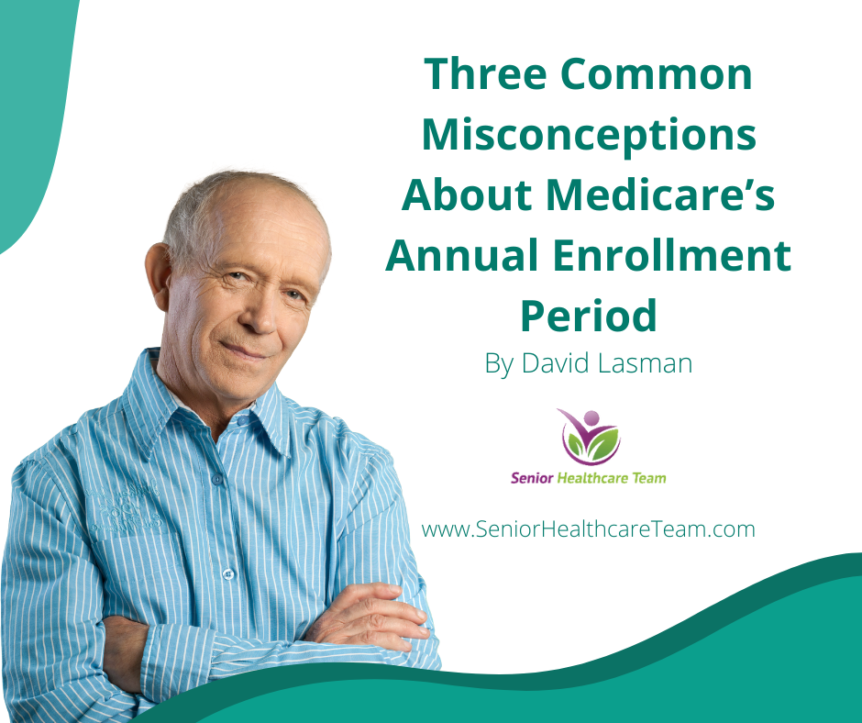Medicare is confusing, so it’s no wonder that several misconceptions have arisen about the Annual Enrollment Period.
The Annual Enrollment Period (AEP) is the time of year when you’re allowed to change your health and drug plans. This time lasts from October 15 to December 7.
Over the years, we’ve consistently seen 3 common myths and misconceptions about the Annual Enrollment Period, and we’re here to clear up the misunderstandings.
Misconception #1: There’s no good reason to change health or drug plans during the Annual Enrollment Period.
The Annual Enrollment Period is actually an opportunity – not a burden. This is the only time of year, outside of special exceptions, when you’re permitted to switch your Medicare Advantage or Part D drug plan.
While switching might seem like a huge hassle, it’s really not a big deal, and you could end up saving yourself hundreds of dollars per year.
You can do some price shopping yourself by using Medicare’s Plan Finder tool. However, if you prefer us to do it, we offer this service free of charge.
As far as drug plans are concerned, it’s very important to do a drug comparison. Medicare Part D plans are allowed to change their formularies – even during the year – which means your prescription drug could be dropped from your plan at any time.
If any of your drugs aren’t covered, it could be at a massive cost to you – especially if any of them are brand-name only drugs. Brand name prescription drugs have been rising in price at about 14 times the average rate of inflation since 2012.
There is quite a list of brand-name drugs that don’t have a generic equivalent. If you’re on any of these drugs, it’s of paramount importance that you do your best to get a drug plan that includes it in their formulary.
Some of the most expensive drugs on the market are for diabetes, rheumatoid arthritis, and Crohn’s disease. The drug Enbrel, which is used to treat Crohn’s disease and rheumatoid arthritis costs nearly $8,000 per month – and that cost is increasing each year at a rate of about 18%.
The bottom line is that drugs can all but ruin your financial stability if you don’t take care to reevaluate your drug plan each and every year.
In addition to formulary changes, your current drug plan can change the deductible, copayments, and coinsurance as they wish. If you stick to your current carrier without even looking at what else is out there, you might be paying much more than you need to.
Misconception #2: I can only change my Medigap policy during the Annual Enrollment Period.
The Annual Enrollment Period is the time when you’re allowed to switch or make changes to your Medicare Advantage plan or your Medicare Part D plan.
Your Medigap policy (also called Medicare Supplement) is not affected by the Annual Enrollment Period at all. You are allowed to switch Medigap carriers at any time during the year. However, you will most likely have to pass medical underwriting to do this unless you qualify for a special exception.
Most individuals find it convenient to change plans (if necessary) at their policy anniversary date. The purpose of changing plans is if you want more comprehensive coverage or if you’d like less comprehensive coverage in exchange for a lower premium.

You can also change carriers in order to save money. Medigap benefits are standardized by law, which means every company must provide the same benefits. That means you can switch companies, keep the same benefits, but ultimately save money.
Let’s say you turned 65 in April, so your Medicare Supplement became effective that month. That means that your policy anniversary date for your Medicare Supplement is in April.
So, the point here is that you can change your Medigap policy during the Annual Enrollment Period, but you can also change it at any point throughout the year as long as you can pass medical underwriting questions.
Misconception #3: There’s no reason to sign up for a drug plan if I don’t take any prescriptions.
Last but not least is the misconception that you should only pay for a Part D drug plan if you’re taking prescriptions.
If you choose not to carry a Part D drug plan when you become eligible, you will start incurring penalties. This happens if you go without Part D or creditable prescription drug coverage for any continuous period of 63 days or more after the end of your Initial Enrollment Period (IEP).
The penalties aren’t that bad, but they do add up over time.
The way the Part D penalty works is that each month you go without coverage, you’re penalized 1% of the national base beneficiary premium. That averages out to be about 35 cents or so right now, but The Centers for Medicare & Medicaid Services (CMS) explain that this can change every year depending on what the national base beneficiary premium is. It shouldn’t change drastically though – likely just a few pennies if things continue as they have been.
If you do the math, two years with no drug coverage would tack on an extra $8.40 to your monthly premium.
That penalty does not go away – you pay that extra premium for the rest of your life.
If you’re not too keen on having the penalty, it may be a good idea to maintain a drug plan. You never know – it could come in handy!
The second reason to sign up for a drug plan even if you don’t take prescriptions is this: there’s only one time a year when you’re allowed to sign up for a Part D drug plan. That’s during the Annual Enrollment Period from October 15-December 7.
If you miss that window, you’re out of luck until the following year.
Prescription drugs can be VERY expensive if you don’t have any insurance, and if you are prescribed an expensive medication in the middle of the year, you will have no choice but to pay for it out of pocket.
We find that most seniors – about 90% to be exact – opt to carry a Part D drug plan because of these reasons. While the lowest premium isn’t always going to mean the lowest out-of-pocket costs for the year, Part D drug premiums aren’t going to break your bank.
Don’t miss out on the opportunities to save money during the Annual Enrollment Period. It only comes once per year!
It’s essential to understand your prescription drug coverage, so let’s make it a little easier by reading this article next: Understanding Medicare Part D: Prescription Drug Plans
By David Lasman – “Ask Medicare Dave” | President – Senior Healthcare Team
wwww.SeniorHealthcareTeam.com | 866-333-7340
Selecting the right healthcare plan through Medicare can be overwhelming and downright stressful. Senior Healthcare Team is a nationwide resource that provides guidance and support about Medicare to seniors at no cost to them and helps them to choose the most suitable insurance plan tailored to their specific needs and budget. Our goal is to educate and empower our clients to make the best decisions regarding their healthcare and clear up the confusion of Medicare. At Senior Healthcare Team, we aren’t partial to any one insurance company. Our loyalty is to our clients and our mission is to provide them with the best healthcare options at the very lowest cost.

